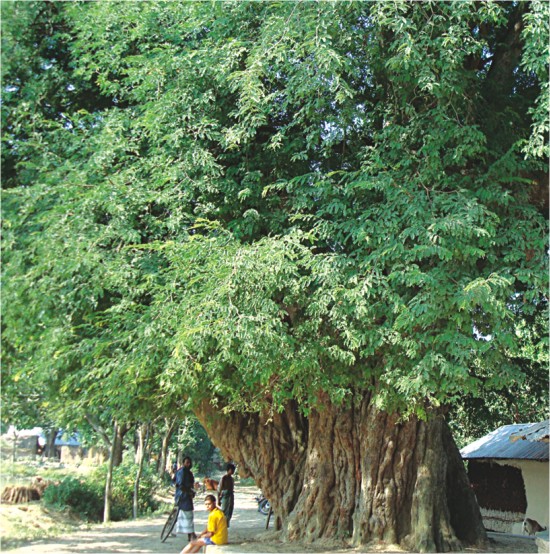| Journey Through Bangladesh
Chapainawabganj
500 year old tamarind tree at Surola village
An interest to nature lovers all over the country, a tamarind tree that's been standing for half a millennium is the highlight of a village.
Rabiul Hasan
The country's oldest tamarind tree, 500 years of age, can be found at Surola village in Nachole upazila in Chapainawabganj, according to Department of Agricultural Extension (DAE) officials. Every year hundreds of people from all over the country come to see the oldest tamarind tree. Locals say that an eco-park could be a good prospect in this area, but the authorities have not taken any steps in that regard.

The Barind is the largest part of the district of Chapainawabganj. Indigenous people called Shantals (pronounced 'Saotal') inhabit the area. These locals say that the tree is at least seven or eight hundred years old. However, after examining the tree and conducting carbon dating experiments, the tree has been declared to be five hundred years old. This proved that this is the oldest tamarind tree not only in Chapainawabganj but also in the country.
Two of the largest branches of the tree were destroyed by a storm about 40 years ago. But the tree lives even today. The indigenous people are proud of this ancient tree even though they were oppressed by the Zaminder in British era. According to the local people, there was a courtyard and a farm house at the Zaminder Kunja Mohon Mitra at Surola village. There was a Kali temple under this tamarind tree. Indigenous people from different places came to this temple to worship Kali. After the abolishment of the Zaminder system, the Kali temple along with this tamarind tree was leased.
 Then the Sub Divisional Officer (SDO) in 1982 leased the property to two men of that area. In 1994, Bimal Kumar Kundu of Surola village lodged a case against that lease at the assistant judge court. Then the Sub Divisional Officer (SDO) in 1982 leased the property to two men of that area. In 1994, Bimal Kumar Kundu of Surola village lodged a case against that lease at the assistant judge court.
When the district administration and the DAE came to know the fact, they cancelled the lease and took steps to recover it. Former Deputy Commissioner of Chapainawabganj, Nurul Haque, took initiative to make an eco park around the tamarind tree. His plan included road construction, electrification and forestation. But nothing has been done except a signboard being hanged.
Khir Bala, the oldest woman of the village told that her mother also saw the tree in the same condition. Satish Chandra Pramanik of the village said, hundreds of cranes come here every Baishakh to lay eggs in the nests on the tree. When the small cranes become mature, the parent cranes fly away. This tree serves as a safe shelter for parrot and owls. Nobody of this locality hunts birds.
Kalpana Rani, a villager, lives near the tree, so she sweeps around the tree and rakes its leaves every day. To her, the tree and the birds are equivalent of her children. DAE officials said, this tamarind tree (tamarind indica) is an ancient monumental tree. This tree has social, biological, ecological and economical importance.
Copyright
(R) thedailystar.net 2009
|


 Then the Sub Divisional Officer (SDO) in 1982 leased the property to two men of that area. In 1994, Bimal Kumar Kundu of Surola village lodged a case against that lease at the assistant judge court.
Then the Sub Divisional Officer (SDO) in 1982 leased the property to two men of that area. In 1994, Bimal Kumar Kundu of Surola village lodged a case against that lease at the assistant judge court.